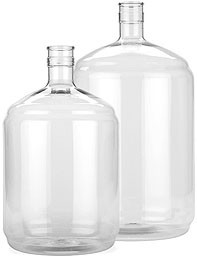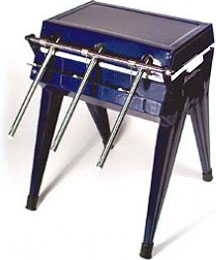 There are many pieces of homemade wine equipment than can be described in just one post. It’s important to understand each piece of homemade wine equipment, how it functions, and whether or not a particular piece of equipment is needed in your own home winemaking practice. Today’s post features three more important pieces of equipment: the Three Spout Bottle Filler, the Wine Thief, and the Brew Hauler Carboy Carrier.
There are many pieces of homemade wine equipment than can be described in just one post. It’s important to understand each piece of homemade wine equipment, how it functions, and whether or not a particular piece of equipment is needed in your own home winemaking practice. Today’s post features three more important pieces of equipment: the Three Spout Bottle Filler, the Wine Thief, and the Brew Hauler Carboy Carrier.
Three Spout Bottle Filler:
This piece of homemade wine equipment comes in very handy when you have a lot of bottles of wine to fill. This bottle filler is best suited for 50 to 500 gallons of wine, which is common for busier home winemakers and small wineries. This piece of homemade wine equipment is gravity-fed, allowing it to be efficiently used without using electricity. Place three wine bottles in line under the three filling rods, push down, and the flow of wine is started. When full, all wine bottles stop at the same exact level, so you never have to worry about a wine bottle being too full or not full enough.
Wine Thief:
 This next piece of homemade wine equipment, while small and simple, is very important for removing samples of wine for various analyses and tests. Not much more than a simple tube with sometimes a bulb on the end, the wine thief can be used to remove wine samples from everything from glass jugs to carboys to barrels and everything in between. These pieces of homemade wine equipment come in different types of material, with the more common being glass and stainless steel. The main difference is that the stainless steel wine thief can be used in more samples, such as samples with very high alcohol or samples that have been heated to a higher degree than the glass could accommodate safely.
This next piece of homemade wine equipment, while small and simple, is very important for removing samples of wine for various analyses and tests. Not much more than a simple tube with sometimes a bulb on the end, the wine thief can be used to remove wine samples from everything from glass jugs to carboys to barrels and everything in between. These pieces of homemade wine equipment come in different types of material, with the more common being glass and stainless steel. The main difference is that the stainless steel wine thief can be used in more samples, such as samples with very high alcohol or samples that have been heated to a higher degree than the glass could accommodate safely.
Brew Hauler Carboy Carrier:
 This final piece of homemade wine equipment is a handy device that once you buy you’ll wonder why you hadn’t always had one. Basically, the Brew Hauler Carboy Carrier aids in – you guessed it – carrying carboys! It’s convenient if you need to move a heavy carboy from one location to another and you are concerned about slippage or dropping. This piece of homemade wine equipment works well for 3 to 7 gallon carboys, and can handle up to 100 pounds. The Brew Hauler Carboy Carrier is an essential piece of equipment for the home winemaker to safely move carboys from one place to another that costs next to nothing!
This final piece of homemade wine equipment is a handy device that once you buy you’ll wonder why you hadn’t always had one. Basically, the Brew Hauler Carboy Carrier aids in – you guessed it – carrying carboys! It’s convenient if you need to move a heavy carboy from one location to another and you are concerned about slippage or dropping. This piece of homemade wine equipment works well for 3 to 7 gallon carboys, and can handle up to 100 pounds. The Brew Hauler Carboy Carrier is an essential piece of equipment for the home winemaker to safely move carboys from one place to another that costs next to nothing!
Understanding the various types of homemade wine equipment will not only save you from headaches, pains, and extra work, but will also help to improve your winemaking skills and ultimately help you create better wines!
Other Winemaking Equipment Guides from the past:
- Winemaking Equipment Guide: Airlocks, Refractometers & Filters
- Winemaking Equipment Guide: Hydrometer, Fermentation Carboys & Bottle Corkers
- Winemaking Equipment Guide: Heating Pad, Transfer Pump & Steam Juicer
———————————————————————————————————
Ed Kraus is a 3rd generation home brewer/winemaker and has been an owner of E. C. Kraus since 1999. He has been helping individuals make better wine and beer for over 25 years.

 Home winemaking, while it can be hard work at times, is a delightful hobby that for some can turn into something more serious such as a second career. For most, however, winemaking provides a lot of pleasure and excitement in creating something that can be enjoyed by not only them but also by friends and family. Before you get to that point, however, you need to start at the beginning and learn how to make your own wine.
Home winemaking, while it can be hard work at times, is a delightful hobby that for some can turn into something more serious such as a second career. For most, however, winemaking provides a lot of pleasure and excitement in creating something that can be enjoyed by not only them but also by friends and family. Before you get to that point, however, you need to start at the beginning and learn how to make your own wine.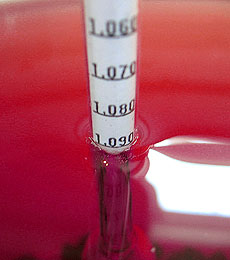 I have been making wine for years and never had any trouble, but I tried a new wine recipe and made a six gallon batch. I’m afraid the specific gravity of the must was too high-1.1200 + and it has stalled out at about 1.100–too sweet. We will not drink wine that sweet. Is there any way I can salvage the 6 gallons by blending or trying to restart fermentation?
I have been making wine for years and never had any trouble, but I tried a new wine recipe and made a six gallon batch. I’m afraid the specific gravity of the must was too high-1.1200 + and it has stalled out at about 1.100–too sweet. We will not drink wine that sweet. Is there any way I can salvage the 6 gallons by blending or trying to restart fermentation? When I do my first racking, there is a lot of carbonation in the wine, and it does not siphon well at all. How should I handle this?
When I do my first racking, there is a lot of carbonation in the wine, and it does not siphon well at all. How should I handle this?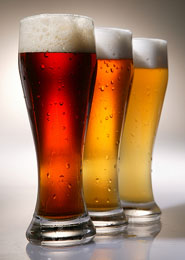 In celebration of the fun, social hobby that is homebrewing, the
In celebration of the fun, social hobby that is homebrewing, the 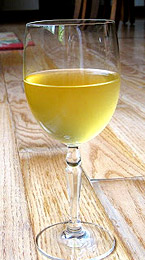 I racked and filtered my Pinot Grigio and it was crystal clear when I bottled it. Now, some bottles (but not all) have a white almost milky sediment in the bottom of the bottles and it has a slightly “dirty sock” aftertaste. I’ve been told it was a protein and I might be able to remove it with Sparkolloid but have not tried it yet. Any suggestions?
I racked and filtered my Pinot Grigio and it was crystal clear when I bottled it. Now, some bottles (but not all) have a white almost milky sediment in the bottom of the bottles and it has a slightly “dirty sock” aftertaste. I’ve been told it was a protein and I might be able to remove it with Sparkolloid but have not tried it yet. Any suggestions?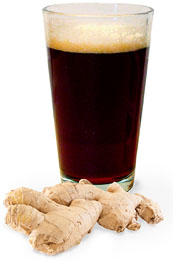 Before hops were a common ingredient, beer was flavored with all kinds of herbs, spices, vegetables, flowers, and roots. One such ingredient was ginger, the intensely flavored root frequently used in cooking Indian food and ginger bread cakes. In one of my favorite new brewing books,
Before hops were a common ingredient, beer was flavored with all kinds of herbs, spices, vegetables, flowers, and roots. One such ingredient was ginger, the intensely flavored root frequently used in cooking Indian food and ginger bread cakes. In one of my favorite new brewing books, 